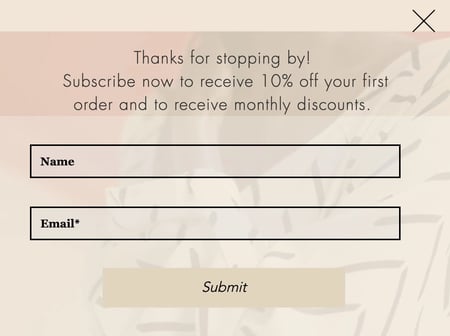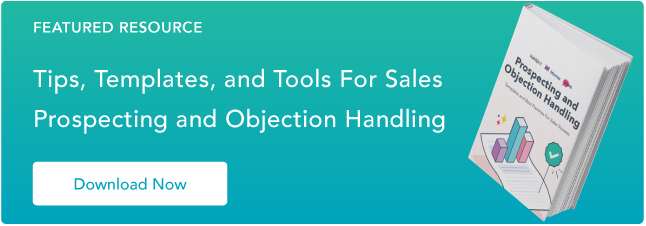It's not impossible. With the skills, empathy, and a plan, you’ll be able to find the prospects who have a need for the products you have to offer. I use the following five techniques to kick things off with these kinds of buyers.
1. Sell the dream.
Not everybody you’re selling to will be interested in your product, but they’re always interested in themselves. Creating a vision of what the prospect's life might be like when they purchase your product is a great place to start.
Think about Nike’s catchphrase, "Just do it," or Burger King’s "Have it your way." These phrases don’t tell you what they sell. They tell you what you can do with the things they sell.
When I call on a VP of Sales at a Fortune 500 company to sell her my firm’s services, I certainly don’t lead with, "Hi! I’m Jeff from Boston, and I sell sales training and consulting products. I’d like to introduce my services. Is this a good time?"
Yawn. That isn’t interesting to her (or me!) and it certainly doesn’t make her curious to find out more. Instead, I do this. As soon as she picks up the phone, I say, "Hi. I got you live on my first dial, and when you hire me, I'll teach your sales reps how to do the exact same thing."
Now, I have her attention. You’ll notice I didn’t even introduce myself or describe my services. Instead, I’ve managed to gain her attention and plant the first seed of curiosity. Only after she's interested, will I then take the time to introduce myself and my services. Now that she’s actually listening, of course.
If you sell copywriting services, you might look for errors on your prospect's website and email them with the corrections, adding, "As your copywriter, I'd ensure your site was 100% typo-free at all times."
If you provide leadership training, you might say, "It looks like you've been hiring a lot of middle managers lately. That often occurs when internal candidates aren't being properly developed. What would it be like to have an 80% internal promotion rate?"
2. Pique their curiosity.
Once you've gotten your prospect to agree to another call, your goal is to keep their attention. I use this strategy to do just that.
At the beginning of the meeting, I'll say, "Before I forget, I want to ask you something related to our last conversation. Let's get into the agenda now, but will you remind me?"
They'll say, "Sure, no problem."
At the end of the call, they'll either ask, "Hey, what was that thing you wanted to talk to me about?", or they won't mention it.
If it's the former, I know they're engaged and present. I've also managed to create a little intrigue. If it's the latter, I know they don't really care (and I should either try a different approach or move on).
Wondering what to bring up? I usually ask something I actually want to know that's too short to include in the agenda, such as, "What percentage of your revenue comes from channel sales versus direct?"
3. Use past successes (not failures) as your guide.
I’ve always found it far more instructive to focus on what went well and try to replicate specific successes, rather than to dwell on mistakes. Our minds often behave like a search engine, displaying the results that reflect your query.
For example, if you Google "don’t show me fast-food restaurants" you are bound to get a massive list of fast-food restaurants. Coincidentally, if you only focus on how things haven’t worked in the past, then that's probably all you will ever see.
The good news is that the same rule applies if you focus on the things that have already worked. One way to reinforce that mindset is to reach out to your current customers and ask about the things that got them interested in your offering.
Look for trends in their responses and then reuse those successful approaches with future prospects. Who knows, they might say, "Hey, that’s not why I took your meeting, I took it for this reason."
The best answers for how to sell can usually be found from the people you have already closed.
4. Enlist your prospect as a teacher.
One of the fastest ways to earn engagement and interest is to understand the fact that your prospect wants to be respected and heard. Learn the opinion of the person you’re speaking with and take that opinion seriously.
Think of it this way; we’d all generally agree we don’t talk to strangers. But if a stranger approaches you on the street and asks for help, you’ll probably help them.
We’re wired to help others, so use that to your advantage when speaking with prospects. If you’re having trouble getting your prospect’s IT director on board, say, "We’ve got to have IT on board for this deal to close. How would you approach this person? What roadblocks do you foresee?"
Use the information they give you to close the deal.
5. Create a sense of urgency.
While we would never encourage you to use scare tactics to make the sale, creating a sense of urgency with prospects who are on the fence about your offer can be a helpful approach.
Here are some ways you can create urgency to get your prospect to invest in your offer:
- Offer a short-term discount or incentive: Whether you provide a lower price for prospects who purchase by a specific end date or include a bonus offer by a specific date, these offers can create a sense of urgency by rewarding decisive action with even greater value.
- Emphasize the immediate benefit of your product: You should have a solid understanding of the problem your prospect is trying to solve. Create a sense of urgency by emphasizing how the purchase of your product can provide an immediate solution or relief to their problem.
- Communicate scarcity: Knowing your offer is limited or only available for a short time can create a sense of urgency for buyers. Whether you are selling a product that is limited-edition, or are selling a service that is only available to a specific number of customers, communicating these parameters during the sales process can entice buyers to make their purchase immediately.
6. Sell your key consumer benefit.
The key consumer benefit — or KCB for short — is the primary benefit that a feature within your product provides to the customer. Now, this isn’t a free pass to rattle off all the features of your product and ask your prospect to buy it. The KCB needs to be communicated from the perspective of “benefit first.”
Here’s what that looks like:
“Your sales team needs help closing their deals faster to keep their pipelines healthy.
67% of sales managers agree that a sales hub software helps reps close deals three times faster than reps who don’t use software.
We know this affects your bottom line, so we’ve developed software that lets you optimize and track that progress in real-time. What types of decisions would you make if you had this kind of data?”
Notice the way this idea is structured? Instead of mentioning the problem first, I explain the need and justify it with something we can both agree on. Then, I set up the feature with some data to build credibility and authority around my product.
Finally, I empathize with the prospect by referencing their bottom line, and I briefly mentioned the product I sell. I finished the statement by asking an open-ended question that invites the prospect to imagine themselves benefitting from the product.
7. Be biased about your product.
I see far too many reps pretending to be unbiased in an effort to sound "credible." The buyer, who is both educated and experienced, expects sales reps to be biased. In fact, nothing you say will make a customer forget that ultimately, your job is to get them to buy your product.
So, stop pretending. If anything, do the opposite: Believe that your service is simply the best.
Your buyer is sophisticated. They understand the use of hyperbole. Embrace the fact that you’re excited about your offering and that you’d love to share your point of view.
When you tell prospects your product is "the best on the market" or that your customer’s sales team "will be blowing out their numbers after working with us," you aren’t having an academic discussion relying on data to defend your conclusion — you’re sharing your opinion. Customers trust those opinions that are authentic and genuine, not merely impartial.
8. Be transparent about your product’s capabilities.
Along the same lines of being biased about your product, you want to be transparent about it, too. Sometimes, that means admitting when your product doesn’t do something exactly the way the client would prefer.
For example, a client wants to know exactly how many leads have been moved to opportunities on a minute-by-minute basis. The software you sell syncs about once an hour. It’s important to be transparent and note that your product doesn’t sync that quickly. However, you don’t have to mention it in the negative. You can always share helpful solutions to issues like this.
Perhaps your product supports integrations with other systems that can sync a bit faster. By reframing product limitations with creative solutions, you can become a helpful resource to your prospect and build trust with them as a result.
9. Be a valuable resource.
Picture this. You’re in the market for a new mattress, and the sales rep at one of the mattress companies you are considering provides stellar service. Not only do they actively listen to your concerns with your current mattress and understand what you’re looking for in your next purchase, they’re able to confidently speak to how their product is the perfect fit for you.
They have been able to get you an answer to every question you asked, and they’ve even shared some valuable content about sleep health, and how their mattress can help you get the best sleep of your life.
This rep has gone above and beyond for you before you even became a customer so just imagine how attentive they will be once you are onboard.
During the sales process, how you treat a prospect while they are still considering your product gives them a glimpse into what life as your customer could look like. If you serve as a resource before they buy, you’re building trust with your prospect that is valuable in the long run.
10. Find common ground.
Your prospects want to find a connection with you, even if it doesn’t seem that way at first. Give them what they want by doing your research beforehand. Find something you have in common, and if you can’t make it your mission to find common ground in the first couple of minutes on your call.
The primary common ground with prospects who are interested in the solution you offer is just that — your product! Leverage this in your initial conversation with the prospect to see why they were interested in speaking with you. You’ll likely uncover a lot more information when they know you have something in common.
11. Make the decision convenient.
When tasks are inconvenient or complicated to complete, we’re less likely to do them. That’s one reason why businesses like Uber, Instacart, and Amazon are so ingrained into our lives.
Consider your prospect’s situation. As a sales rep trying to close a deal, your contract is likely not at the top of their list of things to complete. Making the decision easier for them could be the defining factor.
Perhaps you just need a simple “Yes!” in an email. Giving them a few bullet points that highlight the contract can be the difference between the deal closing in five minutes vs. five days.
Make it known that you understand that they have a busy schedule and you can augment the process to be more convenient. They’ll definitely appreciate the thoughtfulness.
12. Keep the conversation going.
If you don’t succeed in making the sale the first time you pitch, don’t be discouraged. By using the tricks above, you likely have built a level of trust with the prospect that is invaluable. The "no" could very well be a "not right now". Keep the door open with this prospect in case they change their mind, or are a better fit for a different offering. Here are a few ways you can keep in touch with your prospect:
- Connect on social media: If you had a great conversation with a prospect, ask to connect on social media. Seeing what content your prospect shares will give you insight into what products they are using and how they feel about them. Not only that, when they see the content you share, it will keep your conversation and product top-of-mind.
- Ask for feedback: If your prospect is open to providing feedback about your product and sales approach, take them up on it. This feedback provides useful information about how you could improve your sales process in the future and allows you to stay in touch with the prospect longer, which can be helpful for winning them over at a later date or with a different offer.
Attract Customers Online With These Strategies
Not being in person or on the phone poses a unique challenge for sellers as it's more challenging to make a personal connection to help persuade potential customers to buy. Attract customers online with our tips.
1. Provide them with social proof.
Remember when you were younger and your parents harped on the importance of drinking water, saving money, and eating a balanced breakfast? Now, think about how many podcasts and thought leaders you follow that say the same. You listen now, don't you?
No matter how many times you say something, people want to hear it from another source. This has little to do with logic and more to do with bias. People already have their minds made up after a brief encounter with you, your product, or the brand you represent. You can expand their perspective and gain their trust through social proof.
This can be done through highlighting user reviews, articles mentioning your product, or simply other influencers using your product and praising it online.
Example
When Tori Dunlap, founder of financial education platform Her First 100K, was featured in Glamour, she made sure to share it across her social channels.

When potential customers see that your product or service has been vetted and approved by an outside source, it adds credibility to your brand. The boost in popularity may also help convince them to buy.
2. Drive more traffic to your site.
Customers can’t make purchases if they can’t find your site, so making sure your site is Google-friendly is a must. Utilize search engine optimization (SEO) for an organic traffic boost.
Your brand should have a market niche you can target with content tailored to your audience. Each topic you write about should include related keywords you can use to help your article rank higher in Google’s search results. Once users click on your blog, make it easy for them to find your products using a well-placed call-to-action (CTA).
Leverage your social media channels to increase engagement and drive more visitors to your site. Share your articles and other valuable content with your target audience. It’s important to note that organic traffic is not a quick fix, but more of a long-term traffic strategy.
For a quicker jolt of traffic, you can consider paid advertising platforms like Google Ads, Meta for Business, or TikTok for Business. Due to the added expense, going the paid traffic route may not be the best option for small businesses. However, if you have a dedicated marketing budget, paid advertising is a useful tool to have at your disposal.
3. Harness the power of email marketing.
Another method online businesses use to attract and retain customers is email marketing. Once you’ve reeled in users to your site with your amazing content, use a CTA to entice them to sign up for your email list or newsletter. This way you can market to them when they’re not on your site and keep your brand top of mind.
Example
 UK-based design firm HE Creative sent the marketing email above giving me a heads up regarding their new offerings and limited free shippping. In addition to design services, they have a shop with apparel, accessories, posters, and children’s books with a punk rock aesthetic.
UK-based design firm HE Creative sent the marketing email above giving me a heads up regarding their new offerings and limited free shippping. In addition to design services, they have a shop with apparel, accessories, posters, and children’s books with a punk rock aesthetic.
 Sending a targeted email showcasing your new products is a great way to reengage customers. I hadn’t shopped with them in a few months, but I definitely browsed their shop after receiving the email.
Sending a targeted email showcasing your new products is a great way to reengage customers. I hadn’t shopped with them in a few months, but I definitely browsed their shop after receiving the email.
4. Offer an introductory discount for new customers.
Discounts can be a useful tool when trying to attract new customers. It’s not uncommon to see eCommerce businesses offering a discount of 10% to 20% off first purchases.
Example
Women’s clothing brand NGO Bolingo utilized this tactic on their site by using the discount offer in a CTA.

Incentivizing potential customers with a discount is a great way to encourage people to take immediate action and make a purchase.
How to Sell More Products
What’s better than making a sale? Making even more sales. Here are our tips to help you boost sales.
1. Tap into your existing customers.
While it may be tempting to focus your efforts on attracting new customers, chances are your business is already sitting on a goldmine of existing customers. That’s right, your existing customers are more valuable than new ones. In fact, repeat customers spend more on each purchase than new, or first-time buyers.
Introduce them to your new products or retarget them with an email marketing campaign.
2. Introduce a referral program.
Another way to utilize your existing customers is to implement a referral program. Word of mouth is an incredibly valuable marketing strategy and there’s no better way to attract new customers than having current ones vouch for your product or service.
Encourage your existing, happy customers to share their experiences with their colleagues, friends, and associates. As an incentive for bringing in new business, you can offer them a discount or additional services for each referral they bring in.
3. Analyze competitors to see where you can add value.
Do you have competitors selling similar products or services? If so, it’s worth taking stock of what they offer and their marketing strategies. Compare pricing, products, services, and look at their customer reviews. If there is an area where they are falling short, you can capitalize on it by solving for the customer and providing more value.
For example, if you sell product management software, maybe you have an edge over your competitors because your platform has built-in analytics. Whatever your strengths over your competitors are, play them up.
4. Consider using abandoned cart software.
For online sellers, abandoned carts come along with the territory, but you do have options for encouraging customers to complete their purchases. Abandoned cart software is a tool that can help you figure out why customers are leaving your site before completing purchases and can also help you convert them to get more sales.
Plugins like HubSpot for WooCommerce can easily be installed on your eCommerce site, and include features like real-time customer reporting, recovery email templates, customizable coupon codes, and email collection.
Make Your Product Irresistible to Prospects
We’ve touched on a few different ways to sell your products and services to people who are ready to make a decision. The common thread that ties these tactics together is customer empathy. By appealing to your prospect for help, you’ll satisfy their desire to be heard and earn their interest in helping you close the deal — simply by asking for it.
This article was originally published in March 2021 and has been updated for comprehensiveness.
Sales Strategy



.png)

![7 key sales challenges to prepare for in 2026 [+ how you can overcome them]](https://53.fs1.hubspotusercontent-na1.net/hubfs/53/sales-challenges-1-20251023-788058.webp)
![How B2C sales could shift in a recession [new data]](https://53.fs1.hubspotusercontent-na1.net/hubfs/53/Recession%20sales%20strategies%20(1).png)
![22 Best Sales Strategies, Plans, & Initiatives for Success [Templates]](https://53.fs1.hubspotusercontent-na1.net/hubfs/53/Best-Sales-Strategies-1.png)
![What Is Sales? A Quick Guide [+ Examples]](https://53.fs1.hubspotusercontent-na1.net/hubfs/53/what-is-sales-1-20250411-8755735.webp)

![What Is Cross-Selling? Intro, Steps, and Pro Tips [+Data]](https://53.fs1.hubspotusercontent-na1.net/hubfs/53/ft-cross-selling.webp)

